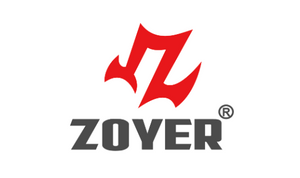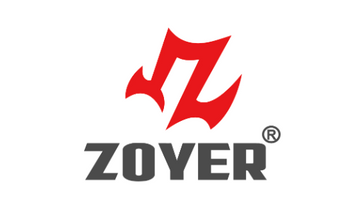What’s the Best Back Brace Posture Corrector for You? A Symptom-Smart Guide to Real Relief
Jun 05, 2025
What’s the Best Back Brace Posture Corrector for You? A Symptom-Smart Guide to Real Relief
Struggling with back pain from poor posture, desk work, or daily fatigue?
This guide breaks down how posture correctors work, which type suits your symptoms, and how to use one effectively—plus, expert tips and product picks to help you stand taller, feel better, and move with confidence.
Why You're Here: Fast Relief for Slouch-Related Back Pain
Looking for a back brace that helps with posture and pain? Here’s everything you need to know—from how posture braces work to which type fits your symptoms best, and which Zoyer models are worth trying for everyday support.
Find Your Posture Solution Now →
Posture, Muscles & Pain — A Quick Anatomy Lesson
You may not have noticed that poor posture is not just about "looking bad"; it can actually affect your muscles, joints, and even nerves.
Below, we will explore why you might experience soreness, pressure points, or feelings of instability in your posture, and provide a simple understanding of the underlying causes of hunching, neck pain, and lower back pain.
How Poor Alignment Strains Your Spine
Your spine isn’t just a stack of bones—it’s a dynamic system of joints, discs, muscles, and nerves. But when your posture is off (thanks, 8-hour Zoom calls), certain areas take on way too much pressure.
Common culprits:
- Rounded shoulders cause tight chest muscles and overworked upper back.
- Forward head posture puts strain on the neck and traps.
- Excessive lumbar curve (or no lumbar curve) stresses the lower back.
And guess what? These imbalances don’t fix themselves.
They often need external support—like a posture-correcting brace—to help your body realign while you work on long-term fixes like stretching and strengthening.
Symptom-to-Solution Map
| Symptom | Over-stressed Tissue | Helpful Brace Feature |
|---|---|---|
| Tech-neck / Upper-cross | Neck extensors, upper traps | Clavicle straps, shoulder retractor |
| Thoracic kyphosis (hunch) | Mid-thoracic extensors | Semi-rigid T-spine panel |
| Lumbar fatigue/tightness | Erector spinae, lumbar discs | Dual-pull lumbar stays |
Do Posture Correctors Really Work? What the Science Says
We get it. The internet’s full of promises—"fix your posture in 5 minutes a day!" But what does actual research say?
In this section, Zoyer will explain, based on clinical research, user experiences, and physical therapy perspectives, why a back brace posture corrector is a truly effective supportive tool and not just a gimmick product on the market.
What Studies Show
- Short-term benefits: Several small studies and clinical reviews have shown that posture braces can reduce pain, improve awareness of body positioning, and provide functional support when worn properly.
- Muscle engagement: The right kind of brace doesn’t just hold you in place like a cast—it cues your muscles to engage and support you actively.
"Posture correction braces, when used correctly and in conjunction with physical therapy, show promising results in reducing kyphosis angles and improving quality of life."
What They Can't Do
- Fix things overnight.
- Replace exercise and rehab.
- Be worn 24/7 (your muscles need to work too!).
Bottom line: Braces aren’t magic, but they are effective tools when used smartly—especially the well-designed ones like those from Zoyer for everyday comfort and support.
How to Choose the Right Back-Brace Posture Corrector
Choosing the wrong posture corrector not only may be ineffective but could also make you feel more uncomfortable!
There are countless products on the market. Below, we provide a small quiz and comparison chart to help you select the corrector that best meets your needs, avoiding wasting money on the wrong purchase.
The 4-Step Fit & Needs Quiz
- Where is your discomfort? Upper, mid, or lower back?
- How intense is it? Mild fatigue or persistent pain?
- What’s your routine like? Desk-bound, active, or in recovery?
- How long will you wear it daily?
Brace-Type Comparison Cheat-Sheet
| Brace Type | Rigidity | Best For | Pros | Cons | Zoyer Pick |
|---|---|---|---|---|---|
| Elastic Posture Band | Soft | Habit cueing / light posture awareness | Discreet, breathable, lightweight | Minimal support | N/A |
| Hybrid Lumbar-Posture | Semi-Rigid | Office workers, mild lumbar fatigue | Good support + flexibility | Not for severe spinal issues | Zoyer Performance |
| Lumbar Rehab Brace | Semi-Rigid+ | Chronic fatigue, light recovery | Comfortable yet structured support | Slightly bulky | Zoyer Recovery |
| High-Stability Brace | Rigid | Severe posture issues, kyphosis | Strong reinforcement & cueing | Warm to wear, noticeable | Zoyer Recovery+ Essential |
*Please note:
Zoyer products are designed for everyday comfort, posture assistance, and discomfort relief. They are not medical devices for treating fractures or other severe medical conditions, which require prescription-based medical-grade braces.
Spotlight: Zoyer Solutions (Clinically Reviewed & User-Approved for Everyday Support)
At Zoyer, we believe that maintaining good posture and finding comfort shouldn't be a medical ordeal.
Our products are designed for everyday individuals seeking non-medical support to alleviate common aches, improve posture awareness, and enhance overall well-being. We focus on U.S. standards, breathable materials, and user-friendly designs, backed by a 30-day money-back guarantee.
Zoyer Performance Back Support Brace
- Designed for:Active users, standing desks, light lumbar support
- Features:8 flexible stays, ergonomic lumbar pad, breathable mesh
- Why it works:Gives you posture reminders and lower back tension relief without restricting movement. It's the perfect choice for those who need dynamic support throughout their day, whether you're at the office, doing light chores, or engaging in everyday activities.
"I wear this during work hours and my back doesn't hurt by 3 p.m. anymore. Totally worth it." —Anna R., verified buyer
Zoyer Recovery Back Brace with Lumbar Support
- Designed for:Moderate to severe lumbar pain, rehabilitation phases (with medical guidance)
- Features:Adjustable compression strap, removable lumbar pad, soft lining
- Why it works:Delivers structured support for tired spines needing help recovering. This brace is ideal for individuals dealing with persistent backaches or seeking consistent, comfortable support for daily tasks, especially during phases where gentle assistance is beneficial after a period of strain.
Zoyer Recovery+ Essential Brace
- Designed for:Max stability, post-injury bracing (with medical guidance), kyphosis control (supportive, not medical)
- Features:Dual-pulley tightening, reinforced spine panel, durable velcro
- Why it works:Offers robust support for everyday use. While still a non-medical solution, its design provides enhanced stability for acute discomfort flare-ups or when you need a stronger postural cue. It's built to give you confidence and firm support throughout your day.
See sizing guide to find your perfect fit.
How to Fit & Wear Your Brace
Getting the most out of your back support isn't just about choosing the right one; it's about wearing it correctly. Improper wear can lead to discomfort or even render the product ineffective.
Prep Checklist
- Breathable undershirt
- Mirror or fitting buddy
- Fresh skin check
5-Step Fitting Guide
- Place lumbar pad at your lower back.
- Wrap the side flaps snugly.
- Tighten center band to secure fit.
- Adjust tension straps or pulleys.
- Move around — you should feel supported, not squeezed.
Wear-Time Ramp-Up Plan
| Days | Max Hours | Activity Notes |
|---|---|---|
| 1–2 | 1 hour | Desk work only |
| 3–5 | 2–3 hours | Add light chores |
| 6–7 | 4 hours | Include light walking/errands |
| 8+ | 6–8 hours | Full usage with breaks |
If you experience sharp pain or numbness—pause and consult a professional.
Real Stories: Users Who Stood Taller
Don't just take our word for it. Hear how Zoyer back supports have made a difference for real people in their everyday lives.
Case Study Snapshots
| User | Zoyer Brace Used | Pain Drop (1-10) | Posture Score (1-5) | Weeks Used | Feedback |
|---|---|---|---|---|---|
| Sam, 32 | Zoyer Performance | 8 → 3 | 2 → 4 | 4 | "My desk job was killing my back. The Performance Brace helps me remember to sit up straight, and the pain is so much better." |
| Mei, 54 | Zoyer Recovery | 7 → 2 | 1 → 4 | 6 | "My chiropractor noticed a change before I even told her I got a brace. That’s how effective it was." |
Share your story! We invite you to submit your own photo and review. Let's build a community of better posture together!
FAQ: Quick Answers from Our Medical Team
We know you have more questions. We've gathered the most common ones and provided answers based on medical insights.
-
Q: Can I sleep in a posture brace?
- A: Only if your doctor advises it. Most people do best wearing non-medical posture correctors during waking hours. Sleeping in one can restrict natural movement and may cause discomfort.
-
Q: Will I get dependent or weaken my muscles?
- A: Not if you also exercise. Zoyer braces encourage good posture habits and should be used as a guide, not a substitute for active muscle engagement. Regular strengthening exercises are crucial for long-term posture improvement.
-
Q: How do I clean it?
- A: Hand wash in cool water with mild soap, then air dry flat. Don’t use bleach or tumble dry. Always refer to the specific care instructions on your Zoyer product's label.
-
Q: Is it covered by insurance?
- A: Most non-medical posture correctors are not covered by health insurance. Some medical-grade braces prescribed by a doctor for specific conditions may qualify for FSA/HSA reimbursement, but this depends on your provider's terms and the medical necessity.
-
Q: Can a posture corrector cure my scoliosis or kyphosis?
- A: For structural conditions like scoliosis or severe kyphosis, a non-medical posture corrector is not a cure. These conditions require professional medical evaluation and often involve specific medical bracing prescribed by a specialist, along with physical therapy. A posture corrector can offer symptomatic relief or postural awareness, but it cannot correct a structural deformity.
-
Q: How long should I wear it each day?
- A: The ideal wear time varies, but a common approach is to start with 1-2 hours a day and gradually increase to 4-8 hours. Listen to your body; if you feel discomfort, take a break. The goal is gentle cueing and support, not constant reliance.
Take the Next Step — Stand Taller, Feel Better
The right back brace posture corrector can change your day-to-day life. Less pain. Better form. And the confidence that you’re doing something good for your health.
Whether you’re desk-bound, in recovery (under medical guidance), or just tired of slouching, Zoyer has a quality, comfortable option for you.
Take the next step:
Your spine will thank you.

